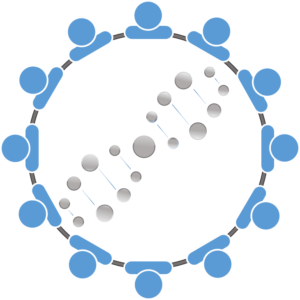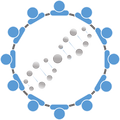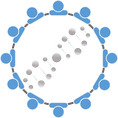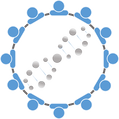Hughes Lab

Group Highlights
Our research aims to understand how people, and other animals, defend themselves against viral infections and how viruses are able to overcome these defences. This knowledge can then inform the development of therapeutics.
Our research is primarily focused on the interplay between innate immunity and paramyxoviruses and pneumoviruses (e.g. parainfluenza viruses [PIV], respiratory syncytial virus [RSV]) that can cause severe respiratory disease, particularly in children.
Our laboratory is based in the School of Biology, Biomedical Sciences Research Complex (BSRC), at the
University of St Andrews, UK.
Our group also has it’s own website: https://hugheslab.weebly.com/
Research
We’re fascinated by a family of proteins, known as ubiquitin-like proteins (e.g. ubiquitin, ISG15, NEDD8, SUMO), and how they shape our responses to infection. We also study how viruses manipulate the functions of these proteins, and other aspect of cell biology, for their own benefit.
Major outbreaks of childhood infections by pathogens such as the mumps and measles viruses continue to cause significant illness in young children despite the availability of effective vaccines. Additionally, infections with viruses for which there is no vaccine – such as parainfluenza viruses – lead to significant numbers of children needing intensive care treatment in hospital. These viruses belong to a highly related group that, in addition to being clinically relevant pathogens, serve as exceptional models in the laboratory for studying how our bodies respond to viral infections – knowledge that has the potential to be translated into effective treatments.
During our first-line defence against virus infection our cells produce factors (including proteins like interferon) aimed at combating the infection. This response, known as the innate immune response, involves the expression of hundreds of genes and places significant stress on our bodies. The products of these genes work in concert to directly target the infection, to trigger the arm of the immune response that involves antibodies and T cells and to regulate the magnitude of the innate response; the latter is essential as an uncontrolled response can lead to autoinflammatory diseases.
Our research aims to understand how the innate immune response is controlled and how can viruses overcome our defences – knowledge that could be used to develop more effective antiviral therapies.
Technical summary:
In recent years, our work has focussed on understanding the interplay between virus infections and the ubiquitin-like (UbL) protein system, utilising DNA viruses (herpesviruses) and RNA viruses (particularly paramyxo- and pneumoviruses) as models. The attachment of UbL proteins to substrates represents one of the most vital posttranslational modifications in the cell and several UbLs have been identified including ubiquitin, NEDD8, SUMO and the interferon-inducible protein ISG15.
Using a multidisciplinary approach, including molecular biology, cell biology & proteomics , the objective of our research is to gain a deeper understanding of virus-host interactions. In doing so, we may also uncover novel therapeutic targets; the primary rationale for studying drugable cellular processes that hinder virus biology is the potential to identify therapies that viruses find harder to develop resistance to.
We recently demonstrated that for the oncogenic Kaposi’s sarcoma-associated herpesvirus (KSHV), NEDDylation is critical for the maintenance of latency and reactivation of virus replication, both of which are required for the pathogenesis Kaposi’s sarcoma. Furthermore, in one of the first studies to demonstrate the potential of targeting this pathway for the treatment of virally-induced malignancy, we uncovered the molecular mechanisms that underpin cytotoxicity due to the inhibition of the NEDDylation pathway (Hughes et al. 2015., PLoS Path).
More recently, the molecular mechanisms that govern ISG15’s antiviral activity, in addition to its importance as a regulator of the antiviral response, has emerged. Our TENOVUS_Scotland-funded work has recently uncovered an exciting new mechanism that inhibits paramyxovirus transcription and replication. In addition, our Academy of Medical Sciences-funded research has begun to dissect the ISG15-dependent mechanisms that are essential for regulated interferon signalling, including identifying previously unknown functions of ISG15.
We have also developed novel tools, currently being marketed by Avacta Life Sciences, which can be used to dissect UbL-associated pathways at the cellular level (Hughes et al., 2017. Science Signaling; Tang et al. 2017, Science Signaling). We are always looking for new ways that we can use our knowledge of UbLs to tell us something about how our cells function. We are currently funded by TENOVUS-Scotland to develop new genome-wide CRISPR/Cas9 screens for improving the identification of virus restriction factors and pathways based on our genetically engineered ISG15.KO cell lines (described in Holthaus et al. 2020) – see our latest review.
Hughes, D. J., Tiede, C., Penswick, N., A. S. Tang, A., Trinh, C. H., Mendal, U., Zajac, K. Z., Gaule, T., Howell, G., Edwards, T. A., Duan, J., Feyfant, E., McPhereson, M. J., Tomlinson, D. C. & Whitehouse, A. 14 Nov 2017 In : Science Signaling. 10, 505, 14 p., eaaj2005Datasets:
Group Members
Group Leader
Dr David Hughes
Postdoctoral Research Fellow
Dr Andri Vasou
Technician
Chris Simmons-Riach
PhD Student
Andrew Seaton – kindly funded by Tenovus
Chloe Jones – kindly funded by the School of Biology
Former Members
David Holthaus (Masters Student – 2018)
Alethea MacPhail (Senior Honours Research Student – 2018)
Miroslav Botev (Senior Honours Research Student – 2018)
Julia Karrer (Masters Student – 2017)
Cassie Cullen (Senior Honours Research Student – 2016)
James Feldman (Senior Honours Research Student – 2015)
Niralini Thayaparan (Visiting Summer Student – 2015)
Natalie Penswick (Research Technician – 2013-2014)
Publications
Chapters
Expression of CCSP and SPLUNC1, Putative Anti-inflammatory Proteins, Following Murine Respiratory Viral Infection
Leeming, GH., Stewart, JP., Hughes, D. J., Bingle, L., Bingle, C. & Kipar, A., 2012, Journal of Comparative Pathology. 1 ed. Vol. 146. p. 49
Research output: Chapter in Book/Report/Conference proceeding › Conference contribution
The role of M1 protein in the acute infection of wood mice with MHV-68 (Murid herpesvirus 4)
Papoula-Pereira, R., Leeming, GH., Hughes, D. J., Sample, JT., Dutia, B., Stewart, JP. & Kipar, A., 2009, Journal of Comparative Pathology. 4 ed. Vol. 141. p. 277
Research output: Chapter in Book/Report/Conference proceeding › Conference contribution
The Epstein-Barr Virus Genome
Sample, JT., Marendy, EM., Hughes, D. J. & Sample, CE., 2008, DNA Tumor Viruses. Springer, p. 241-258
Research output: Chapter in Book/Report/Conference proceeding › Chapter
Murid Herpesvirus 4 as a Model for Gammaherpesvirus Pathogenesis.
Stewart, JP., Hughes, D. J., Roaden, L. & Ebrahimi, B., 2005, SGM Symposium 64: Molecular Pathogenesis of Viral Infections. Digard, P., Nash, AA. & Randall, RE. (eds.). Cambridge University Press, p. 319-341
Research output: Chapter in Book/Report/Conference proceeding › Chapter
Articles
Persistent paramyxovirus infections: in co-infections the parainfluenza virus type 5 persistent phenotype is dominant over the lytic phenotype
Randall, R. E., Young, D. F., Hughes, D. J. & Goodbourn, S., 14 Nov 2023, In: Journal of General Virology. 104, 11, 13 p., 001916.
Research output: Contribution to journal › Article › peer-review
A co-opted ISG15-USP18 binding mechanism normally reserved for deISGylation controls type I IFN signalling
Vasou, A., Nightingale, K., Cetkovska, V., Bamford, C., Andrejeva, J., Randall, R. E., McLauchlan, J., Weekes, M. & Hughes, D. J., 3 Jun 2021, In: biorxiv.
Research output: Contribution to journal › Article
Discovering antiviral restriction factors and pathways using genetic screens
Jones, C. E., Tan, W. S., Grey, F. & Hughes, D. J., 21 May 2021, In: Journal of General Virology. 102, 5, 15 p., 0001603.
Research output: Contribution to journal › Review article › peer-review
Does the zinc finger antiviral protein (ZAP) shape the evolution of herpesvirus genomes?
Lin, Y-T., Chau, L-F., Coutts, H., Mahmoudi, M., Drampa, V., Lee, C-H., Brown, A., Hughes, D. J. & Grey, F., 17 Sept 2021, In: Viruses. 13, 9, 15 p., e1857.
Research output: Contribution to journal › Review article › peer-review
Direct antiviral activity of interferon stimulated genes is responsible for resistance to paramyxoviruses in ISG15-deficient cells
Holthaus, D., Vasou, A., Bamford, C., Andrejeva, J., Paulus, C., Randall, R. E., McLauchlan, J. & Hughes, D. J., 22 Jun 2020, (E-pub ahead of print) In: The Journal of Immunology. 11 p., ji1901472.
Research output: Contribution to journal › Article › peer-review
Innate intracellular antiviral responses restrict the amplification of defective virus genomes of parainfluenza virus type 5
Wignall-Fleming, E. B., Vasou, A., Young, D., Short, J. A. L., Hughes, D. J., Goodbourn, S. & Randall, R. E., 16 Jun 2020, (E-pub ahead of print) In: Journal of Virology. 94, 13, 15 p., 00246-20.
Research output: Contribution to journal › Article › peer-review
The BHLF1 locus of Epstein-Barr virus contributes to viral latency and B-cell immortalization
Yetming, K. D., Lupey-Green, L. N., Biryukov, S., Hughes, D. J., Marendy, E. M., Miranda, J. J. L. & Sample, J. T., 24 Jun 2020, (E-pub ahead of print) In: Journal of Virology. Latest Articles, JVI01215-20.
Research output: Contribution to journal › Article › peer-review
Analysis of paramyxovirus transcription and replication by high-throughput sequencing
Wignall-Fleming, E. B., Hughes, D. J., Vattipally, S., Modha, S., Goodbourn, S., Davison, A. J. & Randall, R. E., 13 Aug 2019, In: Journal of Virology. 93, 17, 17 p., e00571-19.
Research output: Contribution to journal › Article › peer-review
Contribution of the KSHV and EBV lytic cycles to tumourigenesis
Manners, O., Murphy, J., Coleman, A., Hughes, D. J. & Whitehouse, A., Oct 2018, In: Current Opinion in Virology. 32, p. 60-70
Research output: Contribution to journal › Review article › peer-review
Generation of specific inhibitors of SUMO-1- and SUMO-2/3-mediated protein-protein interactions using Affimer (Adhiron) technology
Hughes, D. J., Tiede, C., Penswick, N., Ah-San Tang, A., Trinh, C. H., Mendal, U., Zajac, K. Z., Gaule, T., Howell, G., Edwards, T. A., Duan, J., Feyfant, E., McPhereson, M. J., Tomlinson, D. C. & Whitehouse, A., 14 Nov 2017, In: Science Signaling. 10, 505, 14 p., eaaj2005.
Research output: Contribution to journal › Article › peer-review
Contact
Join us
If you are motivated, enthusiastic and hardworking, we would love to hear from you. If you are a potential intern (e.g. ERASMUS+), MSc(Res) student, PhD student or postdoc wanting to secure (or have secured) funding, and you would like to come and work with us, get in touch.
Current openings
- MSc(Res) projects (see below)
New research only Masters programme – MSc(Res)
Opportunities are available for a 1 year Master of Science by Research, MSc(Res) degree in our laboratory. This degree is purely research-focussed (no exams or viva) and is awarded after submission of a dissertation (up to 30,000 words). More about the MSc(Res). Check out the MSc(Res) Biomedical Sciences info on findamasters.com.
Potential applicants are encouraged to make contact with supervisors before applying.
If this sounds interesting, get in touch.
Contact us
Our laboratory is part of the School of Biology, Biomedical Sciences Research Complex (BSRC):
University of St. Andrews
Biomolecular Sciences Building (BMS)
North Haugh
St. Andrews
Fife
KY16 9ST
United Kingdom
E: [email protected] Twitter: @davejohnhughes (Hughes Lab) Ph: +44 (0) 1334 467197
Related themes:
Related Centre:





